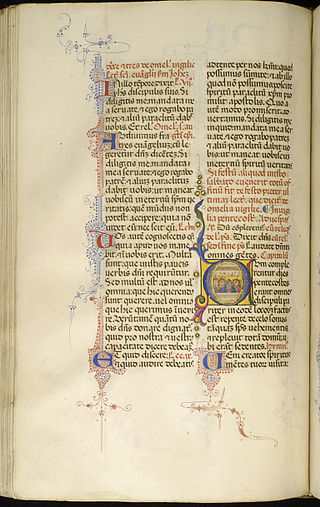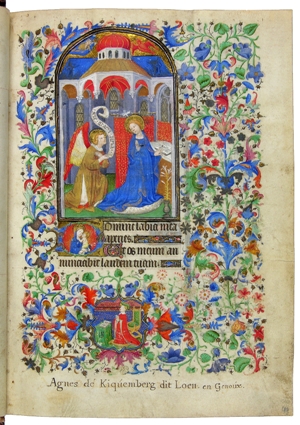Related Research Articles

The Roman Breviary is a breviary of the Roman Rite in the Catholic Church. A liturgical book, it contains public or canonical prayers, hymns, the Psalms, readings, and notations for everyday use, especially by bishops, priests, and deacons in the Divine Office.

Vespers is a liturgy of evening prayer, one of the canonical hours in Catholic, Eastern Orthodox, Oriental Orthodox, and Lutheran liturgies. The word for this fixed prayer time comes from the Latin vesper, meaning "evening".

In the practice of Christianity, canonical hours mark the divisions of the day in terms of fixed times of prayer at regular intervals. A book of hours, chiefly a breviary, normally contains a version of, or selection from, such prayers.

The Te Deum ( or, Latin: [te ˈde.um]; from its incipit, Te Deum laudamus is a Latin Christian hymn traditionally ascribed to AD 387 authorship, but with antecedents that place it much earlier. It is central to the Ambrosian hymnal, which spread throughout the Latin Church with other parts of the Ambrosian Rite of Milan in the 6th to 8th centuries. It is sometimes known as the Ambrosian Hymn, although authorship by Saint Ambrose is unlikely. The term Te Deum can also refer to a short religious service based upon the hymn.

Matins is a canonical hour in Christian liturgy, originally sung during the darkness of early morning.
Christian liturgy is a pattern for worship used by a Christian congregation or denomination on a regular basis. The term liturgy comes from Greek and means "public work". Within Christianity, liturgies descending from the same region, denomination, or culture are described as ritual families.
Vexilla regis prodeunt is a Latin hymn in long metre by the Christian poet and saint Venantius Fortunatus, Bishop of Poitiers. It takes its title from its incipit.

The Liturgy of the Hours or Divine Office or Opus Dei are a set of Catholic prayers comprising the canonical hours, often also referred to as the breviary, of the Latin Church. The Liturgy of the Hours forms the official set of prayers "marking the hours of each day and sanctifying the day with prayer." The term "Liturgy of the Hours" has been retroactively applied to the practices of saying the canonical hours in both the Christian East and West–particularly within the Latin liturgical rites–prior to the Second Vatican Council, and is the official term for the canonical hours promulgated for usage by the Latin Church in 1971. Before 1971, the official form for the Latin Church was the Breviarium Romanum, first published in 1568 with major editions through 1962.

The Office of the Dead or Office for the Dead is a prayer cycle of the Canonical Hours in the Catholic Church, Anglican Church and Lutheran Church, said for the repose of the soul of a decedent. It is the proper reading on All Souls' Day for all departed souls (Purgatory), and can be a votive office on other days when said for a particular decedent. The work is composed of different psalms, scripture, prayers and other parts, divided into The Office of Readings, Lauds, Daytime Prayer, Vespers and Compline.

An antiphonary or antiphonal is one of the liturgical books intended for use in choro, and originally characterized, as its name implies, by the assignment to it principally of the antiphons used in various parts of the Latin liturgical rites.
Acolouthia in the Eastern Orthodox and Eastern Catholic churches, signifies the arrangement of the Divine Services, perhaps because the parts are closely connected and follow in order. In a more restricted sense, the term "acolouth" refers to the fixed portion of the Office. The portions of the Office that are variable are called the Sequences. While the structure and history of the various forms of the Divine Office in the numerous ancient Christian rites is exceedingly rich, the following article will restrict itself to the practice as it evolved in the Eastern Roman (Byzantine) Empire.
Ambrosian chant is the liturgical plainchant repertory of the Ambrosian rite of the Roman Catholic Church, related to but distinct from Gregorian chant. It is primarily associated with the Archdiocese of Milan, and named after St. Ambrose much as Gregorian chant is named after Gregory the Great. It is the only surviving plainchant tradition besides the Gregorian to maintain the official sanction of the Roman Catholic Church.
The Ambrosian hymns are a collection of early hymns of the Latin liturgical rites, whose core of four hymns were by Ambrose of Milan in the 4th century.
Nunc, Sancte, nobis Spiritus is a Christian hymn which has traditionally been attributed to the fourth century St. Ambrose of Milan. However the earliest manuscript tradition for the hymn seems to only go back to the ninth century. The hymn has traditionally been a core part of the prayers at Terce in the Liturgy of the Hours. The reason for this is that the Acts of the Apostles records an event at Pentecost where the apostles are filled with the Holy Spirit. The experience clearly causes the apostles to behave in an unusual way and in chapter 2 verse 15 the Acts of the Apostles states explicitly that the apostles were not drunk because it was only the third hour of the day. As the Acts of the Apostles was so explicit in linking the Pentecost experience of the Apostles to the third hour of the day, Christian hymns and prayers intended to be used at that time of the day, have traditionally made reference to the coming of the Holy Spirit.

The Ambrosian Rite is a Latin Catholic liturgical Western Rite used in the area of Milan. The Traditional Ambrosian Rite is the form of this rite as it was used before the changes that followed the Second Vatican Council.
The ranking of liturgical days in the Roman Rite is a regulation for the liturgy of the Roman Catholic church. It determines for each liturgical day which observance has priority when liturgical dates and times coincide, which texts are used for the celebration of the Holy Mass and the Liturgy of the hours and which liturgical color is assigned to the day or celebration.

Conditor alme siderum, is a seventh-century Latin hymn used during the Christian liturgical season of Advent. It is also known in English as Creator of the Stars of Night, from a translation by J.M. Neale.
Chrysogonus Waddell was an American Roman Catholic convert and theologian. A Trappist monk of the Abbey of Gethsemani, Kentucky, he was an accomplished organist, liturgist, historian, and a scholar of chant and Cistercian liturgy.
Hymnody in continental Europe developed from early liturgical music, especially Gregorian chant. Music became more complicated as embellishments and variations were added, along with influences from secular music. Although vernacular leisen and vernacular or mixed-language carols were sung in the Middle Ages, more vernacular hymnody emerged during the Protestant Reformation, although ecclesiastical Latin continued to be used after the Reformation. Since then, developments have shifted between isorhythmic, homorhythmic, and more rounded musical forms with some lilting. Theological underpinnings influenced the narrative point of view used, with Pietism especially encouraging the use of the first person singular. In the last several centuries, many songs from Evangelicalism have been translated from English into German.
Audi benigne Conditor is a Latin hymn used during Lent attributed to Gregory the Great, who reigned as pope from the year 590 until the year 604.
References
- ↑ Chrysogonus Waddell, The Primitive Cistercian Breviary (Staatsbibliothek zu Berlin, Preussischer Kulturbesitz, Ms. Lat. Oct. 402) with variants from the "Bernardine" Cistercian breviary (Fribourg 2007).
- ↑ Alicia Scarcez, Liturgie et musique à l’Abbaye Cistercienne Notre-Dame de la fille Dieu (Romont). Histoire et catalogue des sources de sept siècles de vie chorale (Fribourg 2015).
- ↑ Chrysogonus Waddell, The Twelfth Century Cistercian Hymnal, 1984, vol. 1, p. 100.
- ↑ Conditor alme siderum instead of Creator alme siderum in Advent, Iam Christe Sol iustitiae instead of O sol salutis intimis in Lent, Ad cenam Agni instead of Ad regias dapes in Eastertide etc.
- ↑ Summi largitor praemii in Lent, Chorus novae Ierusalem in Eastertide, Iesu nostra redemptio for the Feast of the Assumption etc.